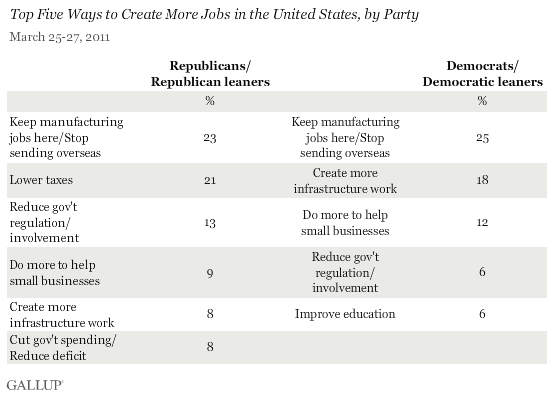PRINCETON, NJ -- One in four Americans say the best way to create more jobs in the U.S. is to keep manufacturing in this country and stop sending work overseas. Americans also suggest creating jobs by increasing infrastructure work, lowering taxes, helping small businesses, and reducing government regulation.

These open-ended results from a March 25-27 Gallup survey are roughly in line with what Americans suggested in November 2009, although more Americans now suggest keeping manufacturing jobs in the U.S.
Americans and their elected representatives are highly focused on employment and jobs at this juncture in history. Gallup's unemployment tracking shows some slight improvement this month, and Gallup finds job creation is more positive than a year ago. Still, Americans consistently say that jobs and the economy are the most important problems facing the country, with 26% citing jobs specifically as the nation's most important problem in March.
The Obama administration has addressed the jobs situation in part by establishing a Council on Jobs and Competitiveness, headed by General Electric CEO Jeffrey Immelt. In a speech on Thursday at the Economic Club of Washington, D.C., Immelt downplayed the role of government in job creation, saying, "Government can work with business to improve the conditions to expand and create jobs. But it can't create and sustain jobs for us. That's our job. The principles of capitalism, competitiveness, innovation, and free markets that have allowed America to lead for generations can win again today."
Three of Americans' top five recommendations for job creation relate directly or indirectly to government actions: creating more infrastructure work, lowering taxes, and reducing government regulation and involvement. The other two -- keeping manufacturing jobs in the U.S. and helping small businesses -- are a little more general in nature, although the government could presumably be involved in each.
Six percent of Americans suggest putting higher taxes on imports, which would be one way the government could indirectly attempt to create more jobs in the United States.
Republicans, Democrats Agree on Keeping Jobs in the U.S., Differ on Other Ideas
Republicans and Democrats alike most commonly mention keeping manufacturing in the U.S. as the best way to create jobs.
Republicans, however, are next most likely to suggest lowering taxes and cutting back on government regulation, while Democrats say creating more infrastructure work and helping small businesses are the best ways to create more jobs.

Bottom Line
This Gallup survey gives the average American the opportunity to weigh in on what he or she would do to create more jobs. Americans clearly remain focused on keeping manufacturing jobs from going overseas, although exactly how this can be done is yet to be determined. This priority persists from the last time Gallup asked this question, in November 2009. Beyond that, Americans are split somewhat along partisan lines in their recommendations for creating more jobs. Republicans are more focused on reducing taxes and government involvement in regulating business. Democrats are somewhat more focused on using government directly to create jobs through infrastructure projects.
Survey Methods
Results for this Gallup poll are based on telephone interviews conducted March 25-27, 2011, with a random sample of 1,027 adults, aged 18 and older, living in the continental U.S., selected using random-digit-dial sampling.
For results based on the total sample of national adults, one can say with 95% confidence that the maximum margin of sampling error is ±4 percentage points.
Interviews are conducted with respondents on landline telephones (for respondents with a landline telephone) and cellular phones (for respondents who are cell phone-only). Each sample includes a minimum quota of 200 cell phone-only respondents and 800 landline respondents, with additional minimum quotas among landline respondents for gender within region. Landline respondents are chosen at random within each household on the basis of which member had the most recent birthday.
Samples are weighted by gender, age, race, education, region, and phone lines. Demographic weighting targets are based on the March 2010 Current Population Survey figures for the aged 18 and older non-institutionalized population living in continental U.S. telephone households. All reported margins of sampling error include the computed design effects for weighting and sample design.
In addition to sampling error, question wording and practical difficulties in conducting surveys can introduce error or bias into the findings of public opinion polls.
View methodology, full question results, and trend data.
For more details on Gallup's polling methodology, visit https://www.gallup.com/.
